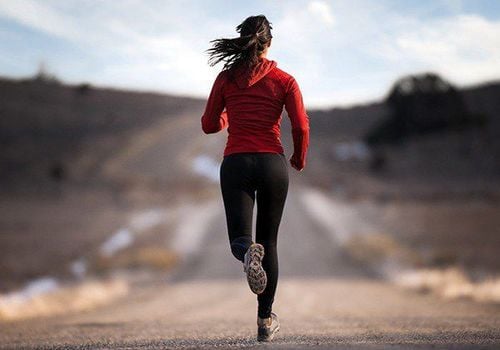This is an automatically translated article.
Marathon is a running sport that many people participate in, organize running tournaments to practice health. The technique of running a marathon is mainly based on the flexibility and endurance of the body, it has many differences compared to other types of running.
1. What is Marathon Running?
Marathon running (Marathon Race) is a sport in the form of running, popular with people around the world. Marathon is a sport that brings a lot of health benefits, but there are also risks if there is no marathon running technique.
Marathon running is of Greek origin, attributed to a man named Pheidippides - he was assigned the important task of announcing the Greek victory to Athens. Pheidippides ran non-stop while participating in this mission. By the time he got there, he was too tired, exhausted, and died of sudden death. To commemorate the merits and valuable contributions of Pheidippides, the Greek people organized an annual Marathon to commemorate the hero Pheidippides. By 1896, at the Olympic Games, Marathon was introduced.
2. Marathon running technique
The technique of running a marathon is mainly based on the flexibility and endurance of the body, it has many differences compared to other types of running.
Marathon runners need to spend a lot of time practicing. Studies show that, in order to run a long distance, runners need to combine three factors: running method, breathing properly and paying attention when running uphill.
Techniques for running a marathon 5km
For starters, it's important to know that warming up is the most important part of your workout. Warm-up techniques can be gentle movements such as butt kicks, knee raises. This will increase flexibility and reduce the risk of injury. Then, walk briskly for five minutes, slowly increasing to a comfortable jogging or running pace.
First day try to run for 30 minutes. Then rest on the second day. On the third day, run again for 30 minutes. On the fourth day, after warming up, you should walk briskly for 30 minutes. On the fifth day, try to run for another 30 minutes. Friday is only for strength training and you should relax and let your body down on Saturday.
On each subsequent week, repeat the same process as the first week. Alternate running with lighter exercise days while gradually increasing your strength training and sprinting.

Khởi động trước khi chạy marathon giúp giảm nguy cơ chấn thương
10km . Marathon running technique
With the technique of running a marathon from 5km to 10km, you have to be consistent and try harder during training. Even if you are experiencing extreme fatigue and bad feelings while running. Be motivated, push yourself to complete the ascending distance at all costs.
You should practice extra sprint once a week. You can do it more easily and smoothly by warming up with a 5-minute walk. Run like a 10-minute jog at an easy pace. Next, start running very fast for about 2 minutes, jogging lightly to recover for 2 minutes.
Run at a gentle pace for more than 10 minutes before finishing walking for five minutes. By working on this routine, once a week for three weeks in a row, you can be ready to increase your sprint.
Techniques for running a 21km marathon (half marathon)
For a half marathon, it is recommended to run four times per week.
Should run faster with 2 sprints, the rest you should do a light run. Start running 1.5 km to warm up and 1.5 km to cool down. Run slower than your 5km speed.
Strength training is essential in a half marathon. It can strengthen your muscles and joints. In addition, it can improve your race time and reduce your risk of sports injuries. If you're just starting out and feel confused about where to start, search for a series of videos online or read an article that offers the right tips and tricks for working out at home.
Conquer a 42km . Marathon
Make sure running 50 to 80 kilometers per week is the bare minimum that the average person should train before doing their first marathon.
Adequate energy, water and minerals are essential when performing marathon running techniques. Besides, planning a scientific and reasonable running schedule are also decisive factors to your marathon race.
3. How to run a Marathon properly
Before runningPractitioners need to warm up carefully to warm up and help lubricate the joints, giving the body a signal that they are about to undergo movement.
In addition, before running a Marathon, it is necessary to walk about 200-300m so that the body tends to change its state from resting to active.
While running
Long stride, higher leg lift than normal jogging. Must set the most comfortable cadence. The point of contact between the ground and the foot is the whole foot instead of the toe like in regular running.
With the initial minutes of running, you should not have a running speed that is too fast, run moderately and rhythmically. At the same time, it helps the body gradually adapt to the change of state from resting to active.
In the marathon running uphill, when running uphill, run as if running on a flat road. When running downhill, run slower, and at the same time keep your breathing rhythmic and regular.
After running
You must not sit or stop completely after running to the finish line. Follow up with muscle relaxation exercises by walking for a while. Muscle relaxation time will range from 5 to 10 minutes, depending on how each person feels.
If you do not relax your body and stretch your muscles after each run, it will be very dangerous, it will make the body tired and tense.
4. How to Breathe When Running Marathon
Breathing plays an extremely important role when running long distances. The way to breathe when running Marathon will be drawn by athletes from previous training sessions. Each person will have a separate breathing rhythm, suitable for the condition and stage of the running track.
Usually, marathon runners choose to breathe when entering, which is 2 breaths 2 in accordance with the rhythm of the running step. Practice breathing through your nose while running a marathon. This will help minimize energy consumption. In particular, the air that passes through the nose is also filtered out of fine dust.

Việc hít thở đóng một vai trò cực kỳ quan trọng khi chạy marathon
5. Tips for running a 42km Marathon for the first time
Consult a specialist or doctor, especially those with health problems such as cardiovascular disease, diabetes or a history of trauma. Take at least 4 months to prepare for the marathon, ideally 6 months, to help your body get used to the pressures to come. Practice 3-5 times/week, gradually increase the total running distance, run with different intensity in distance and speed. Make sure you have enough time to rest and recover. Proper rest reduces the risk of injury and mental exhaustion. Develop a healthy diet strategy. The menu needs to add more carbohydrates during the marathon week, because the body will use carbohydrates for fuel. In short, the technique of running a marathon is mainly based on the flexibility and endurance of the body, it has many differences compared to other types of running. Therefore, marathon runners need to spend a lot of time practicing, combining well the running method, breathing properly and paying attention when running the slope.
Please dial HOTLINE for more information or register for an appointment HERE. Download MyVinmec app to make appointments faster and to manage your bookings easily.













